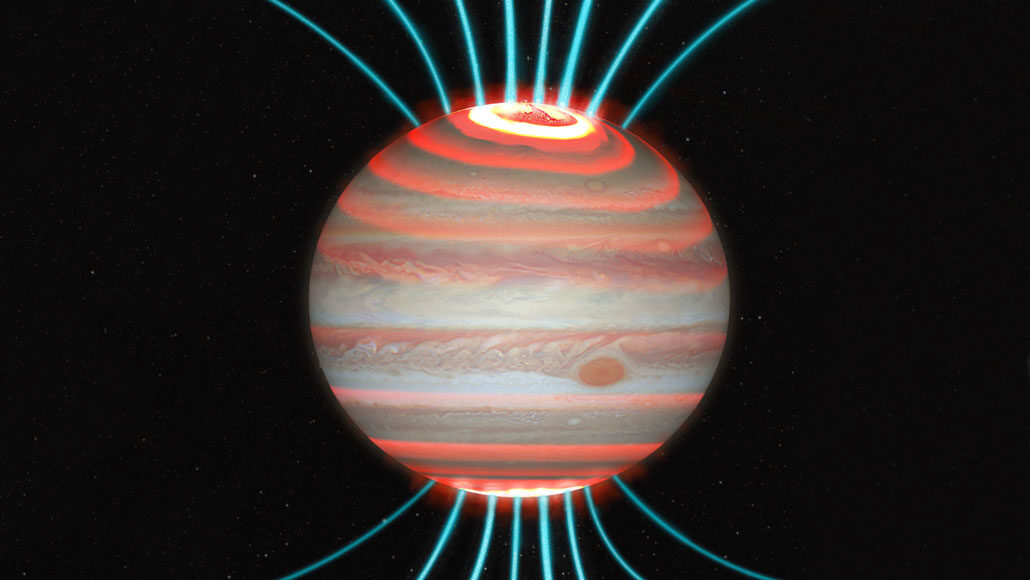atmosphere: The envelope of gases surrounding Earth, another planet or a moon.
aurora: A light display in the sky caused when incoming energetic particles from the sun collide with gas molecules in a planet’s upper atmosphere. The best known of these is Earth’s aurora borealis, or northern lights. On some outer gas planets, like Jupiter and Saturn, the combination of a fast rate of rotation and strong magnetic field leads to high electrical currents in the upper atmosphere, above the planets’ poles. This, too, can cause auroral “light” shows in their upper atmosphere.
cloud: A plume of molecules or particles, such as water droplets, that move under the action of an outside force, such as wind, radiation or water currents. (in atmospheric science) A mass of airborne water droplets and ice crystals that travel as a plume, usually high in Earth’s atmosphere. Its movement is driven by winds.
colleague: Someone who works with another; a co-worker or team member.
computer model: A program that runs on a computer that creates a model, or simulation, of a real-world feature, phenomenon or event.
dormant: Inactive to the point where normal body functions are suspended or slowed down.
equator: An imaginary line around Earth that divides Earth into the Northern and Southern Hemispheres.
gas giant: A giant planet that is made mostly of helium and hydrogen, which on Earth are gases. Jupiter and Saturn are gas giants.
hydrogen: The lightest element in the universe. As a gas, it is colorless, odorless and highly flammable. It’s an integral part of many fuels, fats and chemicals that make up living tissues. It’s made of a single proton (which serves as its nucleus) orbited by a single electron.
infrared: A type of electromagnetic radiation invisible to the human eye. The name incorporates a Latin term and means “below red.” Infrared light has wavelengths longer than those visible to humans. Other invisible wavelengths include X-rays, radio waves and microwaves. Infrared light tends to record the heat signature of an object or environment.
ion: (adj. ionized) An atom or molecule with an electric charge due to the loss or gain of one or more electrons. An ionized gas, or plasma, is where all of the electrons have been separated from their parent atoms.
Jupiter: (in astronomy) The solar system’s largest planet, it has the shortest day length (9 hours, 55 minutes). A gas giant, its low density indicates that this planet is composed mostly of the light elements hydrogen and helium. This planet also releases more heat than it receives from the sun as gravity compresses its mass (and slowly shrinks the planet).
particle: A minute amount of something.
planet: A large celestial object that orbits a star but unlike a star does not generate any visible light.
poles: (in Earth science and astronomy) The cold regions of the planet that exist farthest from the equator; the upper and lower ends of the virtual axis around which a celestial object rotates. (in physics and electrical engineering) The ends of a magnet. (in chemistry) two areas of opposite electrical charge, one positive and one negative.
solar: Having to do with the sun or the radiation it emits. It comes from sol, Latin for sun.
solar flare: An explosive event that takes place on the sun when energy that has built up in 'twisted' magnetic fields (usually above sunspots) becomes suddenly released. The energy can in minutes heat to many millions of degrees, emitting a burst of energy. That energy consists of radiation across the electromagnetic spectrum, from gamma rays to radio waves.
solar wind: A flow of charged particles (including atomic nuclei) that have been ejected from the surface of the star, such as our sun. It can permeate the solar system. This is called a stellar wind, when from a star other than the sun.
sun: The star at the center of Earth’s solar system. It is about 27,000 light-years from the center of the Milky Way galaxy. Also a term for any sunlike star.
telescope: Usually a light-collecting instrument that makes distant objects appear nearer through the use of lenses or a combination of curved mirrors and lenses. Some, however, collect radio emissions (energy from a different portion of the electromagnetic spectrum) through a network of antennas.
wave: A disturbance or variation that travels through space and matter in a regular, oscillating fashion.









